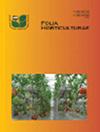Changes in various secondary metabolites by crossing modern rose cultivars
IF 2.2
4区 农林科学
Q2 HORTICULTURE
引用次数: 0
Abstract
The aim of the study was to determine the content and composition of phenolic compounds in autochthonous rose hips (R. pendulina, R. spinosissima and R. gallica) and to compare them with the content of phenolic compounds in their cultivars (‘Harstad’, ‘Bourgogne’, ‘Mount Everest’, ‘Poppius’, ‘Frühlingsduft’, ‘Single Cherry’, ‘Frühlingsmorgen’, ‘ Violacea’ and ‘Splendens’) collected in Arboretum Volčji Potok in Slovenia. The total content of phenolic compounds in the flesh with skin was lowest in ‘Mount Everest’ (3603.57 mg · kg−1 f.w.), which is derived from R. pendulina, and highest in ‘Splendens’ (68789.39 mg · g−1 f.w.), which is derived from R. gallica. In seeds, the phenolic compound content was lower, as expected, ranging from 757.02 mg · kg−1 f.w. (‘Mount Everest’) to 6823.21 mg · kg−1 f.w. (‘Single Cherry’). It can be concluded that the cultivars differ significantly from each other due to the content of different bioactive compounds. Based on the obtained results, we cannot determine to which basic rose plant the cultivar belongs based only on the content of one analysed compound. The contents were very different because only one parent plant is known for a given cultivar and breeding programmes in roses were very narrowly focussed on specific targets.现代玫瑰栽培品种杂交后各种次生代谢物的变化
这项研究的目的是确定本地玫瑰果(R. pendulina、R. spinosissima 和 R. gallica)中酚类化合物的含量和组成,并将其与在斯洛文尼亚沃尔奇波托克植物园采集的栽培品种('Harstad'、'Bourgogne'、'Mount Everest'、'Poppius'、'Frühlingsduft'、'Single Cherry'、'Frühlingsmorgen'、'Violacea'和'Splendens')中的酚类化合物含量进行比较。带皮果肉中的酚类化合物总含量在 "珠穆朗玛峰 "中最低(3603.57 毫克-千克-1(净重)),它来自 R. pendulina,而在 "Splendens "中最高(68789.39 毫克-克-1(净重)),它来自 R. gallica。种子中的酚类化合物含量较低,从 757.02 毫克-千克-1(湿重)('珠穆朗玛峰')到 6823.21 毫克-千克-1(湿重)('单樱')不等。由此可以得出结论,由于不同生物活性化合物的含量不同,各栽培品种之间存在显著差异。根据所得结果,我们无法仅凭一种分析化合物的含量来确定栽培品种属于哪种基本玫瑰植物。由于特定栽培品种只有一种亲本植物,而玫瑰育种计划又非常狭隘地集中在特定目标上,因此其含量差异很大。
本文章由计算机程序翻译,如有差异,请以英文原文为准。
求助全文
约1分钟内获得全文
求助全文
来源期刊

Folia Horticulturae
Agricultural and Biological Sciences-Horticulture
CiteScore
3.40
自引率
0.00%
发文量
13
审稿时长
16 weeks
期刊介绍:
Folia Horticulturae is an international, scientific journal published in English. It covers a broad research spectrum of aspects related to horticultural science that are of interest to a wide scientific community and have an impact on progress in both basic and applied research carried out with the use of horticultural crops and their products. The journal’s aim is to disseminate recent findings and serve as a forum for presenting views as well as for discussing important problems and prospects of modern horticulture, particularly in relation to sustainable production of high yield and quality of horticultural products, including their impact on human health.
 求助内容:
求助内容: 应助结果提醒方式:
应助结果提醒方式:


